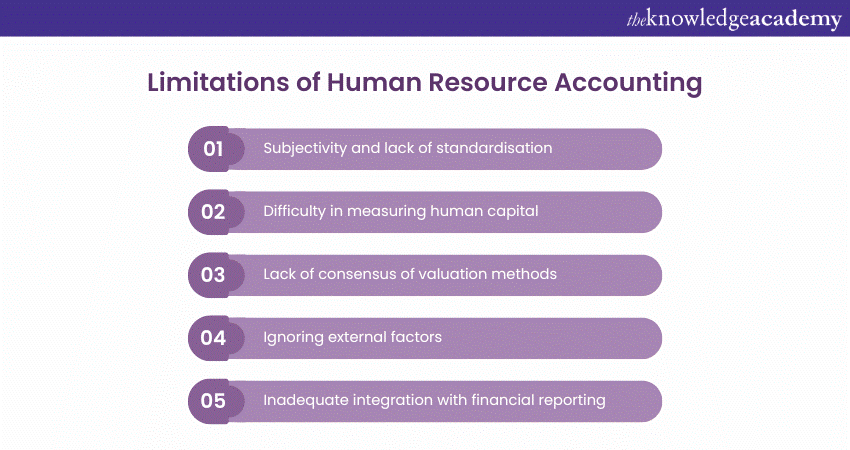We may not have the course you’re looking for. If you enquire or give us a call on 01344203999 and speak to our training experts, we may still be able to help with your training requirements.
Training Outcomes Within Your Budget!
We ensure quality, budget-alignment, and timely delivery by our expert instructors.

Human Resource Accounting (HRA) is a valuable approach that recognises and measures the contribution of human capital to an organisation's success. However, like any accounting methodology, it has its limitations. This blog will explore the top Limitations of Human Resource Accounting and discuss why they pose challenges in assessing the value of Human Resources.
Table of Contents
1) What are the top Limitations of Human Resource Accounting
a) Subjectivity and lack of standardisation
b) Difficulty in measuring human capital
c) Lack of consensus on valuation methods
d) Ignoring external factors
e) Inadequate integration with financial reporting
2) Conclusion
What are the top Limitations of Human Resource Accounting
Human Resource Accounting identifies, measures, and reports the value of Human Resources in financial terms. It involves assessing the costs incurred in hiring, training, and retaining employees and estimating their potential future value to the organisation.
Accurate measurement of human capital helps organisations understand the Return on Investment (ROI) associated with their workforce and facilitates strategic decision-making. It allows them to allocate resources efficiently, identify skill gaps, and develop appropriate Human Resource management strategies.
Human Resources drives organisational growth and competitiveness. Human Resource Accounting aims to quantify the value of Human Resources, enabling organisations to make informed decisions regarding workforce management and development strategies. Despite its benefits, HRA encounters several limitations that hinder its effectiveness. Some of these are:

Join our comprehensive Certified HR Advisor course to take your HR career to new heights.
Subjectivity and lack of standardisation
One of the primary limitations of HRA is the inherent subjectivity involved in its measurements. Unlike tangible assets like machinery or buildings, Human Resources are intangible and difficult to quantify accurately. As a result, valuing human capital often relies on subjective judgments and estimates.
The subjectivity in HRA arises from various factors. For instance, assessing the value of an employee's knowledge, skills, and experience requires subjective judgments about their level of expertise and the potential impact on organisational performance. Similarly, estimating the future value of an individual's contributions to the organisation involves assumptions and projections that personal biases may influence.
Furthermore, the lack of standardised methodologies and frameworks for measuring human capital exacerbates the subjectivity issue. The absence of clear guidelines and universally accepted standards means that different organisations may adopt their own approaches to valuing Human Resources. This variation in calculations and methodologies can lead to discrepancies and hinder meaningful comparisons between companies or industries.
Subjectivity in HRA poses challenges in terms of reliability, consistency, and transparency. When decisions regarding resource allocation, talent management, and strategic planning are based on subjective valuations, the outcomes may be less accurate or reliable. It becomes difficult to ensure consistency and comparability of Human Resource measurements, limiting the usefulness of HRA as a decision-making tool.
Organisations can strive for greater objectivity and transparency in their HRA processes to address this limitation. They can establish clear guidelines and criteria for valuing human capital, minimising the reliance on individual judgments. Regular training and calibration sessions for HR professionals involved in the valuation process can help reduce discrepancies and enhance consistency across the organisation. Additionally, efforts towards standardisation and developing industry-wide frameworks for HRA can contribute to more reliable and comparable Human Resource measurements.
Unlock your HR potential with our comprehensive Introduction To HR course - sign up now!
Difficulty in measuring human capital
Measuring human capital in HRA is complex due to the intangible nature of employee contributions. Traditional accounting methods focus on tangible assets, making it challenging to quantify the value of knowledge, skills, and experience.
The difficulty lies in identifying relevant metrics and establishing reliable measurement techniques. Collecting accurate data, often subjective or qualitative, adds to the complexity. Inadequate measurement may lead to flawed decisions and inefficient resource allocation.
To address this, organisations should define appropriate metrics aligned with strategic goals. They should employ quantitative and qualitative data, continuously refining measurement techniques. Collaboration with experts helps stay up-to-date with best practices. Organisations can make informed decisions to optimise workforce management and enhance performance by effectively measuring and valuing human capital.
Lack of consensus of valuation methods
A limitation in HRA is the absence of a universally accepted valuation method for human capital. Different approaches exist, leading to variations in practices across organisations and industries.
This lack of consensus hampers comparability and consistency in Human Resource measurements, undermining the reliability and credibility of HRA. Organisations can conduct thorough research, promote transparency in valuation practices, and collaborate with industry stakeholders to develop standardised frameworks to address this. By striving for standardisation, organisations can enhance the accuracy and effectiveness of HRA.
Elevate your HR career to new heights with our Certified HR Manager course – register today!
Ignoring external factors
Human Resource Accounting often overlooks the influence of external factors on the value of human capital. While HRA primarily focuses on internal factors such as employee skills and performance, it fails to consider the impact of external circumstances.
External factors such as economic conditions, market trends, and technological advancements significantly affect the value and marketability of Human Resources. Changes in the industry landscape, emerging technologies, or shifts in customer preferences can render certain skills or knowledge obsolete, impacting the value of human capital.
By ignoring external factors, HRA provides an incomplete understanding of the true worth of Human Resources. Organisations need to consider both internal and external dynamics to gain a holistic perspective on the value and potential of their workforce.
Organisations should integrate external factors into their human capital assessment processes to address this limitation. This involves monitoring and analysing industry trends, market conditions, and technological advancements. By staying informed about external influences, organisations can adapt their talent management strategies, invest in relevant training and development programs, and ensure the alignment of their workforce with changing market demands.
Furthermore, collaboration between Human Resources departments and other functions such as strategy, marketing, and finance is essential. This cross-functional approach allows for a comprehensive assessment of the impact of external factors on human capital and facilitates informed decision-making.
Master essential HR skills, even without an HR background. Our HR Skills for Non-HR Managers course is tailored just for you.
Inadequate integration with financial reporting
One of the limitations of HRA is its inadequate integration with financial reporting. While HRA focuses on valuing human capital, it often fails to effectively link this information with an organisation's financial statements.
Financial reporting primarily involves tangible assets and monetary transactions, providing a snapshot of a company's financial position. However, being an intangible asset, human capital is not consistently reflected in financial statements, leading to a gap in reporting.
This limitation poses challenges in presenting a comprehensive view of an organisation's value and performance. The exclusion of human capital from financial reporting can result in an incomplete representation of the organisation's assets and potential. It can also hinder stakeholders' understanding of the impact of Human Resources on the financial health and future prospects of the company.
To address this limitation, efforts should be made to enhance the integration of HRA with financial reporting. This can be achieved through the development of appropriate measurement techniques and reporting frameworks that enable the inclusion of human capital in the company's financial statements.
One approach is to explore the concept of "intellectual capital reporting," which aims to capture and present information related to intangible assets, including human capital, in financial reports. By incorporating relevant metrics and valuation methods into financial reporting, stakeholders can gain a more comprehensive understanding of the organisation's value and the contributions of Human Resources.
Additionally, collaboration between HR and finance departments is crucial in bridging the gap between HRA and financial reporting. By working together, these departments can identify key human capital indicators and develop mechanisms to collect and integrate Human Resource data into financial statements. This collaboration can also help align Human Resource strategies with financial goals and foster a more holistic approach to organisational reporting.

Conclusion
We hope you enjoyed reading this blog on the Limitations of Human Resource Accounting and understood how it can influence how a company manages its workforce. HRA provides valuable insights into the contribution of human capital to organisational success. However, it faces several limitations that pose challenges in accurately measuring and assessing the value of Human Resources. By considering these limitations and addressing them, organisations can enhance their understanding of the value of Human Resources and make informed decisions for their long-term success.
Want to take the next step in your HR career? Explore our wide range of HR Training courses and expand your expertise!







 Top Rated Course
Top Rated Course



 If you wish to make any changes to your course, please
If you wish to make any changes to your course, please


